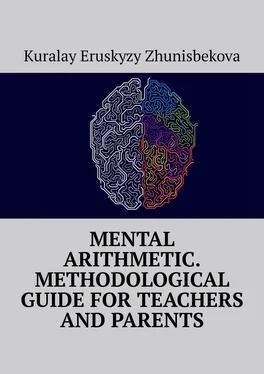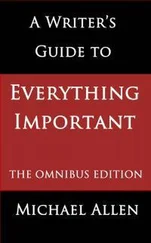Mental arithmetic. Methodological guide for teachers and parents
Kuralay Eruskyzy Zhunisbekova
© Kuralay Eruskyzy Zhunisbekova, 2020
ISBN 978-5-4498-3488-1
Created with Ridero smart publishing system
The manual is written by a teacher of mental arithmetic, chief methodologist, Director of education at the center for mental arithmetic. The author participated in the development of the method of mental arithmetic when it first appeared in the CIS countries. After analyzing the market, I noticed that former colleagues who also became professionals in this field began to open companies, centers, associations that issue certificates in mental arithmetic online training for teachers in mental arithmetic. They realized that the franchise is expensive, and it became cheaper to teach this course themselves.
This book covers most aspects of teaching mental arithmetic so that teachers can teach and develop students using mental arithmetic without going through expensive training, online courses, and even more so without franchises.
This manual is designed to train teachers in mental arithmetic, for managers of children’s centers and other professions related to the training of mental arithmetic. With this book, you can learn all the formulas of addition and subtraction, multiplication and division, learn the method of explaining this course to students, the organization of the teacher’s work (lesson plan, working with parents, exams, Olympiads, standards, reports of the teacher, etc.).
After carefully studying the material, the teacher will be able to achieve excellent results for students, that is, to study the course of mental arithmetic, the teacher will not need to take expensive online or offline courses, buy a franchise.
Also in the introduction, I want to specify the basic concepts.
Mental arithmetic is a method of rapid verbal counting (faster than a calculator counts), based on calculation on special accounts – soroban. Learning to count on the soroban, students will begin a mental count.
Mental score. Students present a soroban in front of them and quickly count on imaginary accounts. It is the mental account that develops both hemispheres of the brain: representing soroban works the right hemisphere, translating the image into numbers works the left hemisphere. In other words, logic, creative and analytical thinking, photographic memory, speed of reaction, and self-confidence increase. The lessons of mental arithmetic use flash cards that develop tasks, dictation by ear, mental dictation, relay races, which also develop fine motor skills of the hands, both hemispheres of the brain, auditory and visual memory, and as a result, improve grades in all subjects.
1. Methods of teaching students
1.1 Fundamental exercises (FE)
Fundamental exerises – examples that you need to perform every day to develop your fingers, to increase the speed of solving examples, in the future, they will also help in the transition to a mental account. They change depending on the topic, the formula passed in the lesson. Fundamental exercises must be performed quickly, following the finger technique. Three fingers of the left hand hold the soroban (little finger, ring finger, thumb). With your thumb, lift the bones (fold them), and with your index finger, lower them (take them away). The upper bone, i.e. 5, is raised and lowered with the index finger. On soroban, we count the fingers of the right hand (both left-handed and right-handed).
According to the Japanese method on soroban you need to think like this:
– the thumb and forefinger of the right hand
– middle and index fingers of the left hand.
The other fingers of the left hand hold the soroban. It is convenient when students solve examples on 3—4 digit numbers for speed. When we decide on 3—4 digits, then in the middle we use the hands that are convenient for students. The finger technique should be followed from the first lessons.
Fundamental exercises should be performed after a new topic, before the final dictation, and before each homework assignment.
FE is needed for fixing formulas and increasing the speed of solving examples. Develops fine motor skills of the hands, which also affects intelligence and speech.
The teacher can create their own games / relays of FE THAT will arouse the interest of students, parents and competitors.
The teacher is recommended to know examples for FE by heart or have them with him in the classroom.
For example, FE to the formula +4 junior fellows.
1+4
2+4
3+4
4+4
FE to the formula +9 senior fellows
1+9
2+9
3+9
4+9
6+9
7+9
8+9
9+9
FE to work out all the formulas
6+6+6+…=60
7+7+7+…=70
8+8+8+…=80
9+9+9+…=90
60-6-6…=0
70-7-7….=0
80-8-8-…=0
90-9-9…=0
Flash cards – this is a card with the image of soroban’s spokes with numbers typed on them. With these flash cards, many games are played, they are shown to children, with maximum speed, and children should have time to understand what number they saw. The teacher very quickly alternates flash cards in front of the students. Students, without lowering their heads, write down numbers from flash cards. Even if the records are sloppy-the main thing is to have time (and fun). This exercise trains mindfulness, visual memory, and speed. Students also learn the image of the number on the abacus faster. Then the exchange of notebooks and mutual verification.
This is a special exercise designed to help children learn how to write as quickly as possible. We mark the time (1—2 minutes) and students write numbers for time and speed. For example, lines from 0 to 9, from 0 to 100, from 100 to 0, and so on.
1.4 Solving examples by ear (oral dictation)
Oral dictation-dictation during which children count on soroban under the dictation of the teacher and the answers are recorded in a notebook. The teacher dictates examples by sticking to the plan and getting a little faster than the children can decide. When dictating, you need to consider the possibility of children who have the maximum speed, and not on slow ones. Strives for maximum speed necessarily from the first lesson: 10 examples in 30 seconds.
By increasing the speed of dictating examples for children, we increase the speed of thinking. At the same time, an interesting story, when solving examples, the child should be very focused and take the most correct version of the action.
Mutual verification. Children exchange notebooks and check each other while the teacher dictates the correct answers.
Dictate examples must be accelerated despite the pace of children. Be sure to complicate the dictation, the number of rows in the dictation, if you know that students can do it. This is easy to check: if all children cope with most examples correctly, then you need to complicate the dictation.
Most students must solve about half of the examples in dictation. If students decide more than half, the teacher quickly dictates. If less, too fast. It is desirable that there should be such statistics: 1 excellent student (solves almost all examples), most solve half, 1 poor student (solves 30% of examples).
The speed of dictation depends primarily on the performance of the group. We focus on the fastest student and dictate a little faster than the fastest student decides.
Standards for ages and levels are made at the discretion of the teacher. The goal of mental arithmetic is not fast counting, but the development of both hemispheres of the brain, and fast counting is already a positive cost. You always need to complicate examples and dictation (dictate two-digit, three-digit, complicate the row, increase the speed of dictation, etc.). After level 4, students of all ages are compared in terms of decision speed and performance.
Читать дальше












